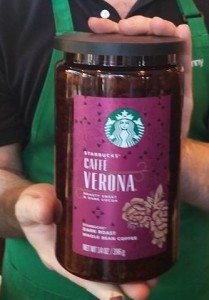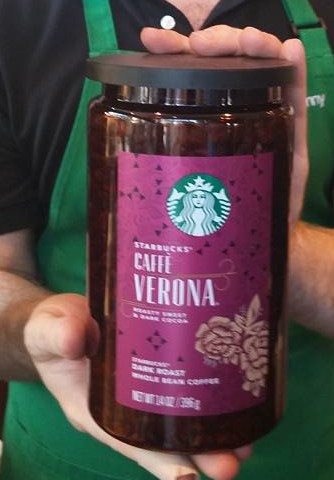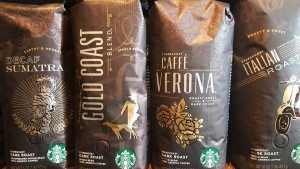 A reader used the “Submit a pic” button on this website, and submitted an image of Starbucks whole bean coffee in a canister, not in Flavorlock packaging. I know very little about this. I heard that this was spotted in Richmond, Virginia and that it’s a test of different whole packaging. I don’t know how long it has been in testing, nor how long it is scheduled to be in testing.
A reader used the “Submit a pic” button on this website, and submitted an image of Starbucks whole bean coffee in a canister, not in Flavorlock packaging. I know very little about this. I heard that this was spotted in Richmond, Virginia and that it’s a test of different whole packaging. I don’t know how long it has been in testing, nor how long it is scheduled to be in testing.
The current whole bean packaging is Flavorlock packaging, which is a bag designed to keep the coffee fresh, but with a small one-way valve on it. The purpose of the one-way valve is to allow the coffee to de-gas. Immediately after roasting, all coffee lets off some gases, so having the valve lets coffee expel those gases. The basic style of packaging, meaning this plastic Flavorlock bag, has been in use for decades, although the designs on the bags have changed over the years.
The story of the standard Flavorlock packaging, which is now the industry standard, begins in the 1980s. From Pour Your Heart Into It, “In 1989, we figured out an answer to what seemed an impossible conundrum. We began using FlavorLock bags, a kind of vacuum packaging with a one-way valve to allow carbon dioxide gases to escape without allowing harmful air and moisture in. This device, used by Starbucks in the early 1980s for wholesale customers only, enabled us to preserve freshness by putting coffee in five-pound silver bags right and roasting and sealing the flavor in before shipping. Once the bag is opened, the fresh flavor begins to decline, so the coffee must be sold within seven days or we donate it to charity.
In retrospect, the reintroduction of FlavorLock bags was a key decision that made our expansion strategy feasible. It allowed us to sell and serve coffee with the highest freshness standards even stores thousands of miles from our roasting plant.” (page 117 of Pour Your Heart Into It).
Flavorlock packaging is enormously effective at what it does: preserves the freshness of the coffee. Light and moisture do not get into the bag. I’ve heard the bag itself is designed with about six micro-fine layers of plastic and at least one metallic layer. (Don’t quote me on that – I’m not sure that I have that exactly right in terms of the bag design.) One thing for sure, Flavorlock packaging, which is now the industry standard, is not recyclable.
The only major reason I can think of to move to new packaging would be to attempt to create fully-recyclable packaging.
Here’s the current sexy packaging!
The current look of the packaging has been around since about 2013. I posted the above pic in a Facebook group, and someone immediately commented on how cool it is to try and find all the hidden symbols and messages on the bags!
What would you think of Starbucks coffee in jars, tubs, bottles or canisters?
Edit on May 13, 2016: Notice in the comments, one person (who appears to be familiar with the test packaging) indicates that the new jars of whole bean hold 14 ounces of coffee, not ounces like the coffee in Flavorlock bags.
Related posts
8 Comments
Leave a Reply Cancel reply
You must be logged in to post a comment.
Sponsors
Recent Comments
- DEVIN on Compostable Straws Land in Seattle Starbucks Stores
- coffeebeanz on Why do you go to Starbucks less often? (If that’s true for you)
- Willi on You can now buy a Siren statue: $6,000
- Willi on A major revamp of your drink recipe: Testing syrup extracts and cane sugar
- Skip on Why do you go to Starbucks less often? (If that’s true for you)








This is fantastic. I remember a Christmas several years ago when a Starbucks coffee was sold with a glass canister that had an airtight lid. I don’t remember which coffee it came with… it was a pound size package. The canister was re-usable. I’m wondering if these would be as well.
Being reasonably aware of the issues of consuming foods stored in plastic containers, I inherently trust the current coffee packages and would guess that is plastic. So my immediate reaction is negative, but I have no doubt that I would give them a try and likely forget about the switchover in time (if they worked out ok).
For customers who get their coffee ground in stores I can see this being great for them. It is an easy way to access the ground coffee rather than fishing in the bag or transferring to another container.
Plus you can upcycle the container when you’re done. An interesting idea, but I am sure it will also increase the price of a pound.
Everybody makes great points. I don’t know the “why” behind this test, but it sure seems like it might relate to being able to recycle or upcycle the containers. Nicholas, you’re right – This would be so much easier for customers who want their coffee ground inside the store!
Does this new packaging allow de-gassing, like Flavor-Lock?
I think this would be a great gimmick…maybe for someone who wants to give a lb as a gift? Otherwise I’m seeing it as a price increase, overall. I also think it’d be a problem for storage in the stores.
I have two of those great “Tribute” canisters that came out with the new Siren? I love them, gave a few as gifts. Later got another one with a red top. They are perfect for counter space and a nice seal. I just put my coffee in its bag in one of these and clamp the bag inside. I love them.
Don’t see this other idea as useful or practical, except as I said above…maybe as a gift.
Make sure you notice that the new packaging only holds 14oz whilst the old packaging held 16oz.
Local Richmond stores seem to vary on whether they will bypass extra packaging and refill the plastic canisters. One store offered a 10 percent discount for beans-only sale, while another store said they weren’t doing that, but obligingly offered to do it as a customer service.